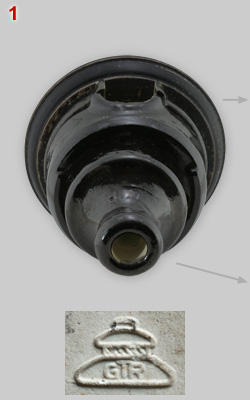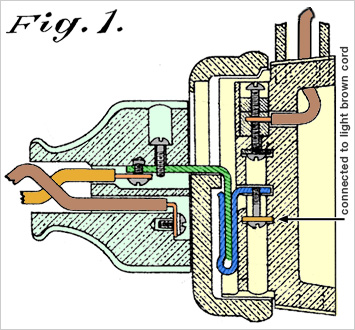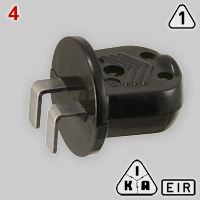 |
Classic continental European Hook plug and socket |
other specials |
 |
Classic continental European Hook plug and socket |
other specials |
| Nearly all plugs have at least two, round
or straight blade
pins. However, plugs with very different typess of pins have been
designed. One of them is a hook plug that has two sharply bent blades. The rectangular folded blades fit in hook sockets that have U-shaped contact blades. The design dates back to the early twentieth century and were, mainly used in the German states Thuringia and Sachsen. Hook plugs became obsolete in the late twentieth century. Plugs with a concentric pin is another example of a different plug type. In contrast to hook plugs they are still in use, notably on cargo ships. Concentric plugs are shown on a separate page. |
 |
 |
 |
| 1 - 3 |
Surface
mount, black glazed steatite wall socket and matching plug. The plug
has 6.7 mm wide rectangular bent blades. These German plugs and sockets were referred to as Hakenstecker and Hakensteckdose (hook plugs and sockets). Image no. 3 shows the socket without top half to illustrate U-shaped socket contacts. The shown plug and socket, rated at 6A - 250V, are probably made in around 1910. Manufacturer: Georg Thiel Metallwarenfabrik in Ruhla (GTR), Thüringen, Germany. {WN} Hook plugs are polarized, a safe but rather uncommon property of not earthed plugs. Touching socket contacts and/or plug blades under tension is hardly possible. Mounting hook sockets in vertical position, as image no. 3 shows, is preferred. |
| An Austrian patent was applied for a Steckkuplung
für den Anschluß beweglicher elektrischer Leitungen
(plug
connection for movable electrical cords) by Firma Thiel &
Schuchardt, Metallwarenfabrik, vormals (=former) Georg Thiel in
Ruhla
in Thüringen. Application date: 17 March 1913; patent no. 65305 was granted 1 January 1914. Image left, is based on figure 1 of the patent. Identical patents have been granted in Switzerland (no. 66585), Hungary (no. 63233) and France (no. 456087); each was applied and granted in 1913. A German patent has not been found. Possibly there was already a patent for a similar type of connector, but there is no indication that the patented type has taken into production. These non-standard devices are probably used only for special purposes; see also "Spezialsteckdosen und Stecker für Sondertarife". Hook plugs that have been made late 1900s - early 1910s have a GTR (Georg Thiel Ruhla) logo. When Arthur Schuchardt joined the company board the GTR loge was replaced by a TS logo. The German manufacturers list gives more information  about the company. Reiner Hahn's patent and GTR research is highly appreciated. |
 green: hook plug; yellow and blue: hook socket brown: cords. Image is based on the Austrian patent. |
| 4 |
Hook plugs remained in use in the former DDR (German
Democratic Republic). Image no. 4 shows a DDR made 10A plug. The size of the Bakelite cast is comparable to the steatite plug shown in image nos 2 and 3. Blade width is 6.5 mm; spacing is 15 mm (center to center), identical to the 6A porcelain plug. The 10A plug fits in the 6A steatite socket. {RH} The DDR plug has a grade 1 TGL quality mark and has been made bythe VEB Installation, Kabel und Apparaten in Leipzig (IKA). In 1958 IKA became a part of a larger conglomerate based in Ruhla, Thüringen (EIR = Elektroinstallation Ruhla). |
 |
Image right is based on a German 1930 wholesaler catalog. The heading indicates: Special sockets and plugs for special tariffs*. ungesichert = not earthed; unverwechselbar = polarized. Aufputz = surface mount; Unterputz = flush mount. Isoliermaterial refers to Bakelite, rather than porcelain. * different tariffs for home illumination, cooking and commercial applications were quite common. Regional electricity providers may have used different types of matching plugs. See also different Schuko types. A polarized plug may point to the use for workplaces machinery. |
 |
| |
D i g i t a l M u s e u m o f | |
P l u g s a n d S o c k e t s | |